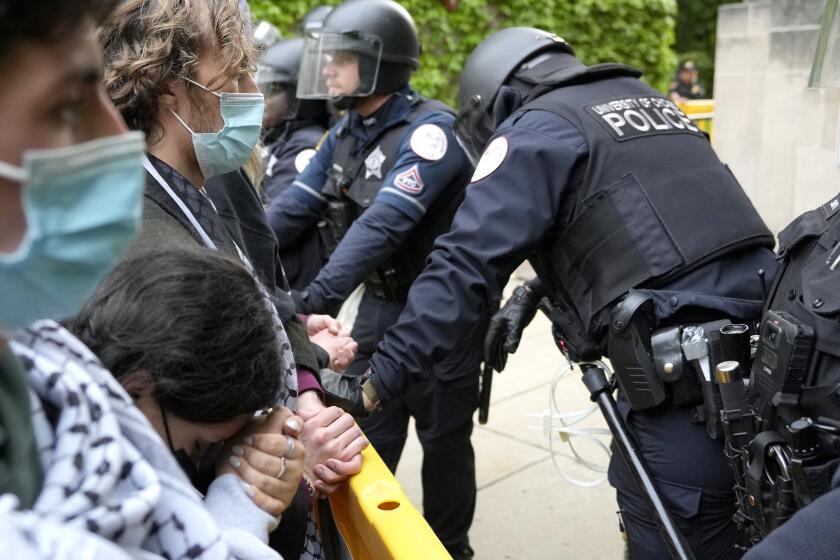PE Makes the Grade at Two City Schools : Magnets Mix Studies, Sports
For five days this week, the students at Green Elementary School get to be Olympic athletes. They’re running dashes and relays, doing standing long jumps and running long jumps, shooting baskets and throwing softballs before a crowd of cheering parents.
The glory of competing in the Junior Olympics only lasts a week but these students, from kindergartners to sixth-graders, are in training for it all year. For Green is one of two magnet schools in the San Diego Unified School District that places as much of an emphasis on physical education as it does on reading, writing and arithmetic.
Green and its companion school, Fulton Elementary, were turned into athletic and academic magnets in 1979 as part of plan to encourage voluntary desegregation of the city’s schools. Students from minority communities are bused to Green, located in predominantly white San Carlos, and white students are bused to Fulton, situated in a predominantly black section of Southeast San Diego.
Unlike other elementary schools, where the daily 20 minutes of physical education are taught by the classroom teacher, the magnets offer 45-minute gym classes taught by certified physical education teachers. In addition, the magnet students have the opportunity to participate in a variety of athletic activities during lunch and recess periods.
“For some children, sports is going to be their career, but that is not our goal,” said Green Principal Carol Voelker. “We’re not here to train future athletes and future Olympians. This is an exposure program--we want to expose them to a lot of different sports.”
Jean Bush, who has been teaching physical education at Fulton since it became a magnet, said that when the program began some parents hoped it would turn their children into professional athletes, but that this is no longer the case.
“We do have kids who want to come here for the gymnastics, I’ve heard that,” Bush said. “But when parents come in and see our facilities, it’s clear there’s no way we can train Olympians here.”
Instead, the programs begin at the kindergarten level by focusing on basic skills--from running and jumping to throwing and catching--that are used in a variety of sports (“before they become uncoordinated, we coordinate them,” Bush said). The children then get training in individual activities such as swimming and gymnastics and team sports such as volleyball, basketball and soccer.
Both schools emphasize academics as well as athletics, and staff members say they’ve been successful as magnets because their curricula are not intimidating to students who don’t have special skills.
“Kids that maybe wouldn’t attend a foreign language or computer science magnet might be interested in attending an athletic and academic one,” said August Castille, principal of Fulton. “The kids we get for the most part are in need of basic academic skills. Their parents are looking for that as well.”
The schools have made an effort to combine academic and athletic activities so students can develop confidence in their abilities in both areas. At Fulton, Bush has designed a triathlon-inspired contest that has students competing in both academic and sporting events. Students work their way through a mile run, a reading test, some basketball dribbling and shooting, a math test and an obstacle course.
“It’s a neat competition because it’s not all physical,” Bush said. “Some kids train for it, but it’s not necessarily the best athletes that win.”
Although both schools sponsor competitive events, the instructors maintain that their goal is to teach good sportsmanship.
“The social aspect is the main thing--the self-esteem and camaraderie that develops,” said Joan Hastings, senior physical education teacher at Green. “I think all of them have something that they do well or, at least that they like.”
“I’ve never seen children brag because they won and cry because they lost,” said Voelker.
The same is true at Fulton where, Bush said, the children are taught to strive to improve themselves rather than beat others.
“The goal is to achieve better than you did the time before,” Bush said. “You don’t compete against others, you compete against yourself.”
The emphasis on teamwork has helped the students, who come from a wide range of ethnic and class backgrounds, learn to get along, she added.
“When we started the magnet we had fights all the time and now we don’t,” said Bush. “The negative energy is not there.”
“It’s been very successful,” Hastings agreed. “If they’re doing this for integration purposes, I think it’s worked well.”
The programs offered by Fulton and Green are unusual in a state where budget cuts have left public school athletics programs in disarray, but Voelker and Castille think that a greater emphasis on sports at all grade levels is the wave of the future.
They point to the current health interest among adults and the widespread disappointment with the poor showing made by U.S. teams at the Winter Olympics as signs that physical fitness is starting to become a national priority.
“I think whenever we criticize an area, then we start pouring money into it,” Castille said. “When we found we couldn’t read, we poured money into reading. When we found we didn’t have math skills, we started pouring money into math. Now we’ve found that we’re not in very good shape and we’ll begin pouring money into physical fitness.”
Joan Hastings, the senior physical education teacher at Green, thinks that all schools should be responsible for providing students with outlets for physical activity, beginning at an early age.
“Physical education should begin right with academics,” Hastings said. “Children are coming home and sitting in front of the TV and stagnating, where we used to climb a tree or play hopscotch. The motivated parent will get their child in Little League or some other activity, but many working parents don’t have time or can’t afford it.”
Source of Dismay
The staffs of both schools are dismayed at the minimal athletic offerings at San Diego’s junior high and high schools.
“A lot of kids have very bright talent, but if their parents don’t have the money to put them in a special program, it’s lost,” said Hastings.
The district has not formally studied whether or not Green and Fulton graduates continue to participate in athletic activities, but teachers at both schools can name former students who have gone on to become top high school athletes.
“I read names in the paper,” said Hastings. “I was reading about a game that Patrick Henry High School won and the winning pitcher had gone to this school.”
Bush said that a number of her former students have gone on to become track stars.
“Students I had nine years ago have gone all-state in track in high school,” she said. “I ran into a kid last week who just got a full track scholarship to San Diego State.” Although they can’t hide the pride they feel when they talk about former students who have excelled in competitive sports, staff members at both schools insist their main concern is that all students learn the importance of keeping fit.
“You look at PE in a secondary school today and if they’re not on a football team, they get no athletic training,” said Hastings. “But if we can turn them on at this level and get them to like (sports), they’ll be physically active the rest of their lives. I’m not going to get out and run a marathon myself, but I like to hit a few tennis balls or ride my bicycle.”
More to Read
Go beyond the scoreboard
Get the latest on L.A.'s teams in the daily Sports Report newsletter.
You may occasionally receive promotional content from the Los Angeles Times.




